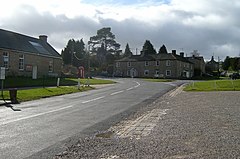Romaldkirk
Human settlement in England From Wikipedia, the free encyclopedia
Human settlement in England From Wikipedia, the free encyclopedia
Romaldkirk is a village in Teesdale, in the Pennines of England. The village lies within the historic boundaries of the North Riding of Yorkshire, but has been administered by County Durham since 1974.
| Romaldkirk | |
|---|---|
 Romaldkirk village main street | |
Location within County Durham | |
| Population | 169 (2011)[1] |
| OS grid reference | NY994220 |
| Unitary authority | |
| Ceremonial county | |
| Region | |
| Country | England |
| Sovereign state | United Kingdom |
| Post town | Barnard Castle |
| Postcode district | DL12 |
| Police | Durham |
| Fire | County Durham and Darlington |
| Ambulance | North East |
| UK Parliament | |
It is thought that the name might be derived from St. Rumwold (also spelt Romald or Rumbold), a little-known Saxon saint who is said to have preached the Gospel after his baptism as an infant; his resting place is recorded as being in Buckingham.
The village was formerly served by Romaldkirk railway station.
Thomas Page, the engineer, grew up in Romaldkirk.[2]
The architects Maxwell Fry and Jane Drew, and famous farmer Hannah Hauxwell are buried near the village church.
The church is a Grade 1 listed building, containing surviving sections of Anglo-Saxon walls either side of the chancel arch, as well as a late medieval rood stair, a stone tomb effigy of Hugh Fitz Henry (who died on campaign with Edward I in 1305) in chain mail, a 12th-century font, and a pulpit (originally part of a three decker) from the early 18th century.[3]
Seamless Wikipedia browsing. On steroids.
Every time you click a link to Wikipedia, Wiktionary or Wikiquote in your browser's search results, it will show the modern Wikiwand interface.
Wikiwand extension is a five stars, simple, with minimum permission required to keep your browsing private, safe and transparent.